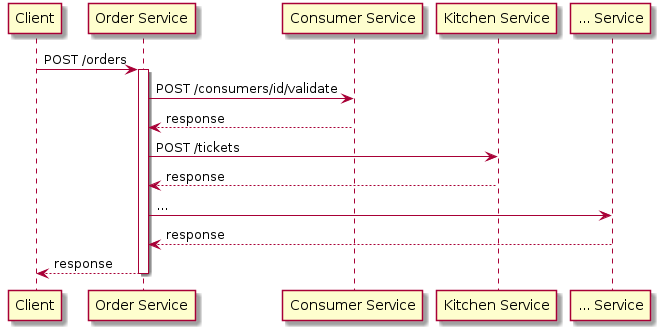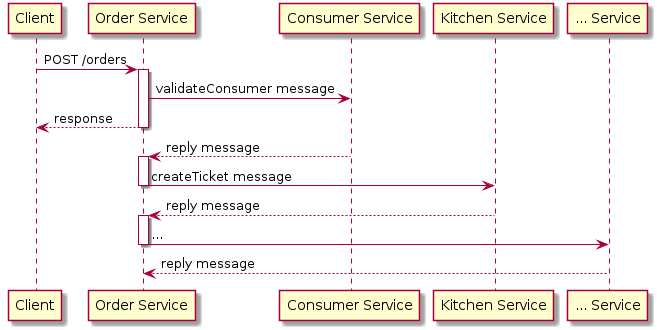Self-contained service
pattern loose couplingContext
Consider, the FTGO application, which is an online food delivery application.
A client of application creates an order by making an HTTP POST /orders request and expects a response, say, within 600ms.
Because the FTGO application uses the microservice architecture, the responsibilities that implement order creation are scattered across multiple services.
The POST request is first routed to the Order Service, which must then collaborate with the following services:
Restaurant Service- knows the restaurant’s menu and pricesConsumer Service- knows the state of theConsumerthat places the orderKitchen Service- creates aTicket, which tells the chef what to cookAccounting Service- authorizes the consumer’s credit card
The Order Service could invoke each of these services using synchronous request/response.
It might, for example, implement the inter-service communication using REST or gRPC.

However, a key drawback of using synchronous request/response is that it reduces availability.
That’s because if any of the Order Sevice’s collaborators are unavailable, it will not be able to create the order and must return an error to the client.
An alternative approach is to eliminate all synchronous communication between the Order Service and its collaborators by using the CQRS and Saga patterns.
The Order Service can use the CQRS pattern to maintain a replica of the restaurant menu’s and there by eliminate the need to synchronously fetch data from the Restaurant Service.
It can validate the order asynchronously by using the Saga pattern.
The Order Service creates an Order in a PENDING state and sends back a response to the POST /order.
It then completes the creation of the order by communicating asynchronously with the other services.

A key benefit of this approach is that it improves availability.
The Order Service always respond to a POST /orders request even when one of the other services is unavailable.
One drawback, however, of using a saga to complete the creation of the order is that the response to the POST doesn’t tell the client whether the order was approved.
The client must find out by periodically invoking GET /orders/{orderId}.
Problem
How should a service collaborate with other services when handling a synchronous request?
Forces
- The microservice architecture often distributes the responsibility of handling a request amongst multiple services
- An operation is typically required to be highly available with a low response time
- The availability of an operation is the product of the availabilities of the services that are invoked while handling a request: serviceAvailabilitynumberOfSynchronouslyCollaboratingServices
- A service can retry a request to a failed collaborator but this increases response time.
Solution
Design a service so that it can respond to a synchronous request without waiting for the response from any other service.

One way to make a service self-contained is to implement needed functionality as a service module rather than a separate service.
We could, for example, merge the Order Service and Restaurant Service.
Another way to make a service self-contained is for it to collaborate with other services using the CQRS and the Saga patterns. A self-contained service uses the Saga pattern to asynchronously maintain data consistency. It uses the CQRS pattern to maintain a replica of data owned by other services.
Example
The Order Service in the FTGO application described earlier is an example of a self-contained service.
The createOrder() operation, for example, queries a CQRS replica of data owned by the Restaurant Service to validate and price the order, and then initiates a saga to finish the creation of the order.
Resulting Context
This pattern has the following benefits:
- Improved availability and response time
This pattern has the following drawbacks:
- Increased cost and complexity of using CQRS
- Increased complexity of using sagas
- Less straightforward API when using sagas
- Larger service due to functionality being implemented in the service instead of as a separate service
Related patterns
- Microservice architecture - creates the need for this pattern
- Saga - used by a service self-contained to asynchronously maintain data consistency
- CQRS - used by a service self-contained to maintain a replica of data owned by other services


 Premium content now available for paid subscribers at
Premium content now available for paid subscribers at 




